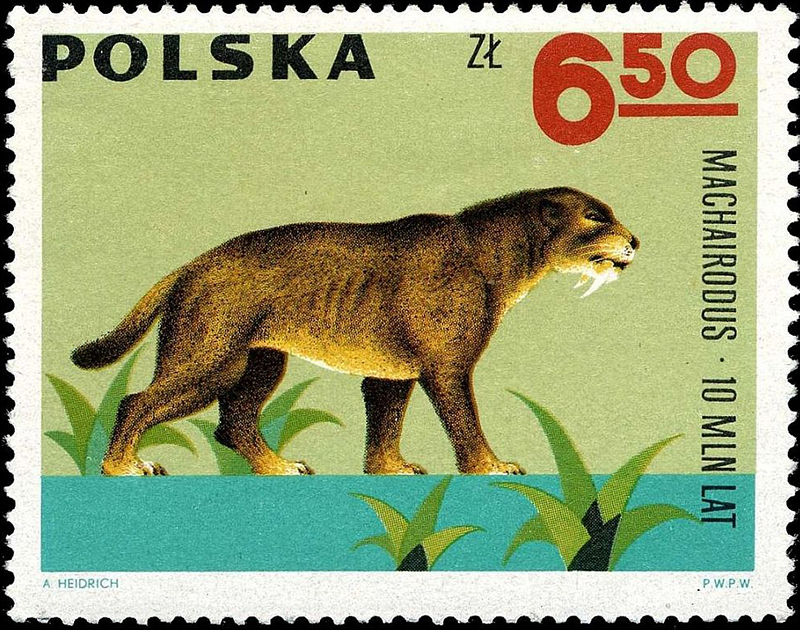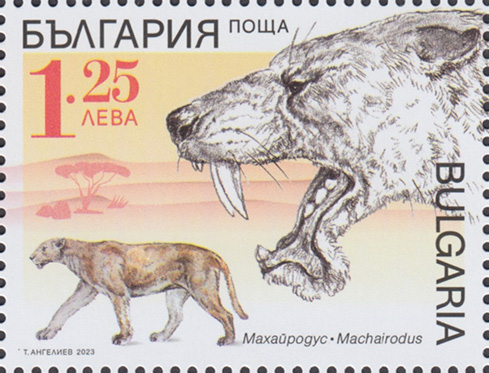Machairodus sp.

Phylum: Chordata Haeckel, 1874
Subphylum: Vertebrata Cuvier, 1812
Classe: Mammalia Linnaeus, 1758
Ordine: Carnivora Bowdich, 1821
Famiglia: Felidae Fischer von Waldheim, 1817
Genere: Machairodus Kaup, 1833
Specie e sottospecie
Il genere annovera attualmente le seguenti specie: Machairodus aphanistus Kaup, 1832 - Machairodus kurteni Sotnikova, 1991 - Machairodus robinsoni Kurtén, 1975 - Machairodus kabir Peigné, 2005 - Machairodus horribilis Schlosser, 1903 - Machairodus lahayishupup Orcut, 2021.
Descrizione
La sottofamiglia dei macairodontini (Machairodontinae), che comprende tutte le tigri dai denti a sciabola, prende il nome da questo predatore, uno dei principali del Miocene. Le dimensioni del macairodo erano variabili da specie a specie, e le forme più antiche e primitive (ad esempio M. aphanistus) erano grandi quanto un piccolo leopardo. Le specie più evolute e tarde, invece, raggiungevano le dimensioni di una tigre: da ricordare M. coloradensis del Nordamerica e M. giganteus dell'Eurasia. La caratteristica principale del macairodo è data dall'allungamento dei canini superiori, a forma di sciabola. Queste straordinarie zanne non erano ancora così lunghe come nei generi Megantereon e Smilodon, ma rappresentavano comunque armi micidiali con le quali il macairodo poteva lacerare la gola degli erbivori del periodo (ad esempio i cavalli Hipparion) e lasciare che si dissanguassero. La struttura corporea di Machairodus suggerisce che questo animale si stesse specializzando nel tendere agguati piuttosto che nell'inseguire prede, anche se le specie più antiche potrebbero benissimo essere state cacciatrici attive. L'evoluzione del genere porterà in seguito alla comparsa di Homotherium.
Diffusione
Grande felide vissuto nel Miocene e nel Pliocene in Eurasia e in Nordamerica.
Bibliografia
–"PBDB". paleobiodb.org. Retrieved 2021-07-04.
–Black, Corbin (2023-10-12). "The Biggest, Baddest Prehistoric Cats that Hunted Giant Prey". Cole & Marmalade.
–Roberts, George (1839). An etymological and explanatory dictionary of the terms and language of geology. London: Longman, Orme, Brown, Green, & Longmans. p. 103.
–J.A. Orlov (1936). "Tertiäre Raubtiere des westlichen Siberiens. I. Machairodontinae, Trav. Inst. Paléozool". Acad. Sci. URSS (in German). 5: 111-152.
–Kurtén, B. (1976). "Fossil Carnivora from the Late Tertiary of Bled Douarah and Cherichira, Tunisia". Notes du Service Géologique de Tunisie. 42: 177-214.
–Beaumont, G. de (1978). "Notes complementaires sur quelques fe´lide´s (Carnivores)". Archives des Sciences, Gene've. 31: 219-27.
–Lungu, A. N. (1978). "The Hipparion fauna of the middle Sarmatian of Moldavia (carnivorous mammals)". Izd. Shtiintsa, Kishinev (in Russian): 132.
–Ginsburg, L.; Morales, J.; Soria, D. (1981). "Nuevos datos sobre los carnívoros de los Valles de Fuentidueña (Segovia)". Estud Geol (in Spanish). 37: 383-415.
–Fernández-Monescillo, Marcos; Antón, Mauricio; Salesa, Manuel J. (2019). "Palaeoecological implications of the sympatric distribution of two species of Machairodus (Felidae, Machairodontinae, Homotherini) in the Late Miocene of los Valles de Fuentidueña (Segovia, Spain)". Historical Biology. 31 (7): 903-913.
–Sotnikova, M. V. (1991). "A new species of Machairodus from the late Miocene Kalmakpai locality in eastern Kazakhstan (USSR)". Annales Zoologici Fennici. 28 (3/4): 361-369.
–Turner, Alan (1997). The Big Cats and their fossil relatives. Columbia University Press. pp. 45.
–Fernandez-Monescillo, Marcos; Anton, Mauricio; Salesa, Manuel.J (2017). "Alaeoecological implications of the sympatric distribution of two species ofMachairodus (Felidae, Machairodontinae, Homotherini) in the Late Miocene of Los Valles de Fuentidueña (Segovia, Spain)". Historical Biology. 31 (7): 903-913.
–Giovanni G. Bellani (2019). Felines of the World. Discoveries in Taxonomic Classification and History. Elsevier Science. p. 31.
–Switek, Brian (November 3, 2016). "The Biggest Saber Cat". Scientific American.
–Sokol, Joshua (14 March 2020). "They Knew Saber-Toothed Tigers Were Big. Then They Found This Skull". The New York Times.
–Orcutt, John D.; Calede, Jonathan J.M. (2021). "Quantitative Analyses of Feliform Humeri Reveal the Existence of a Very Large Cat in North America During the Miocene". Journal of Mammalian Evolution. 28 (3): 729-751.
–Lazaro, Enrico de (4 May 2021). "Giant Saber-Toothed Cat Roamed North America during Miocene | Paleontology | Sci-News.com". Sci.News: Breaking Science News.
–Deng, Tao; Zhang, Yun-Xiang. "A skull of Machairodus horribilis and new evidence for gigantism as a mode of mosaic evolution in machairodonts (Felidae, Carnivora)". Vertebrata PalAsiatica. 54: 302-318 - via ResearchGate.
–Legendre, S.; Roth, C. (1988). "Correlation of carnassial tooth size and body weight in recent carnivores (Mammalia)". Historical Biology. 1 (1): 85-98.
–Turner, Alan (1997). The Big Cats and Their Fossil Relatives. Illustrated by Mauricio Antón. Columbia University Press. p. 233.
–Antón, Mauricio; Salesa, Manuel J.; Siliceo, Gema (2013). "Machairodont adaptations and affinities of the Holarctic late Miocene homotherin Machairodus(Mammalia, Carnivora, Felidae): the case of Machairodus catocopis Cope, 1887". Journal of Vertebrate Paleontology. 33 (5): 1202-1213.
–Antón, Mauricio; Siliceo, Gema; Pastor, Juan Francisco; Morales, Jorge; Salesa, Manuel J. (2020). "The early evolution of the sabre-toothed felid killing bite: The significance of the cervical morphology of Machairodus aphanistus (Carnivora: Felidae: Machairodontinae)". Zoological Journal of the Linnean Society. 188: 319-342.

|
Data: 05/03/1966
Emissione: Animali preistorici Stato: Poland |
|---|

|
Data: 07/04/2023
Emissione: Mammiferi del Miocene Stato: Macedonia Nota: Emesso in un foglietto di 4 v. diversi |
|---|